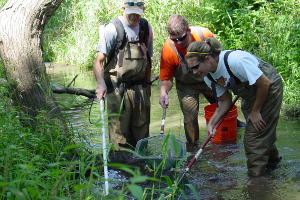The State Hygienic Laboratory Limnology sections are based in Ankeny and Coralville. The limnologists frequently work in partnership with the Iowa Department of Natural Resources, U.S. Environmental Protection Agency, the U.S. Fish and Wildlife Service, the U.S. Geological Survey, several universities, numerous public and private conservation groups, private consulting firms, and individuals to collect and analyze samples of surface water, wastewater and groundwater.
For the Iowa Department of Natural Resources alone, Limnology staff collect samples from more than 200 different waterways (Iowa’s lakes, rivers, streams and impoundments). Some samples are collected on a monthly or biweekly basis. Analyses vary but can include bacteria, nutrients, heavy metals, pesticides, biological organisms and physical measurements.
Results from this monitoring and analysis provide insight into water quality. The program also generates data that can aid state regulators who make decisions about the protection of Iowa’s vital natural resources.

What is Limnology?
Originally, the word limnology was used in reference to the study of lakes and is derived from the Greek word limnos, meaning pool, lake or swamp. Though the field of limnology has largely developed through the study of lakes, the scope has broadened over the years to embrace any fresh or salt waters, which are contained within continental boundaries. This includes lakes, reservoirs, rivers, streams, estuaries, and often overlooked microhabitats like springs, fens, and bogs. Limnology involves the physical, chemical, and biological characteristics and processes of aquatic systems and their watersheds.
Iowa's Water Resources
Iowa has several large flood control reservoirs and many small impoundments. Some natural lakes occur in northwest and north central Iowa (30 lakes over 100 acres). However, the state's network of rivers and streams represent the vast majority of our water resources. Our rivers provide drinking water; water for industry, cooling, cleaning, and crops and livestock;, , water for the production of electric power and water for transportation/navigation routes. Unfortunately, the same rivers often must carry away the wastes produced by these activities. The aesthetic and recreational value of our rivers and streams is also important for Iowa's water resources.

Evaluating Water Quality
The Limnology Section devotes most of its time sampling Iowa's surface waters (usually rivers and streams) and evaluating both water quality and the impact of human activity. Iowa's water quality standards are largely based on chemical criteria-- the concentrations of various chemical compounds cannot exceed certain levels under certain conditions in our surface waters. As a result, water sampling and chemical analyses are vital to evaluating water quality. However, chemical monitoring is really just a snapshot of the conditions at the time of sampling. For example, most of the fish kills in the state are related to very short-term events, often associated with a manure/chemical spill or precipitation event. The slug of polluted water may be present at a location on a stream for only a few hours, and is likely to be missed by routine chemical monitoring. Incorporating biological monitoring into the evaluation process helps to complete the picture of a stream's condition. The fish, aquatic insects and other invertebrates in a stream are continuously exposed to what is in the water, and the species display varying water quality tolerances. Some require clean, nearly pristine conditions while some tolerate, and even thrive, in somewhat poor water quality. Stream inhabitants (fish and bugs) also reflect the physical (habitat) quality of a stream. Water quality assessments typically involve one or more of the following:
- Water chemistry
- Quantifying physical/structural (habitat) aspects of a water of body
- Characterizing biological communities present (fish, benthic macroinvertebrates, and algae and macrophyte surveys)




